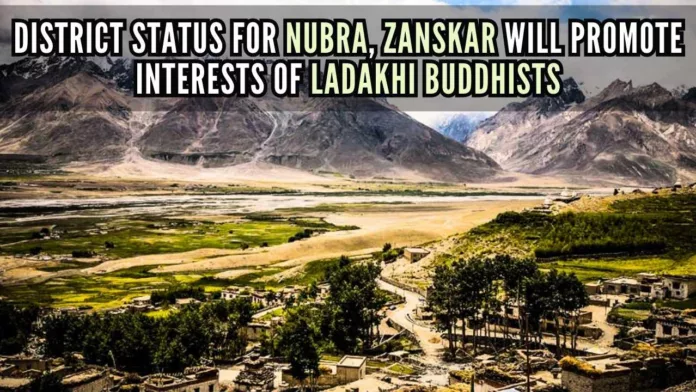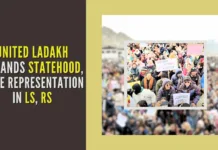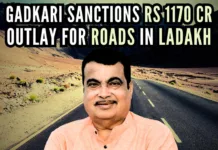
The creation of Nubra, Zanskar as two more districts in Ladakh is being actively considered
The July 10, 2023 report in a leading English language local daily – Daily Excelsior – that the Union government and the Ladakh Union Territory administration are unlikely to confer full state status on the strategic trans-Himalayan region and that they are – apart from strengthening the two Autonomous Hill Development Councils of Leh and Kargil – are likely to concede the long-pending demand seeking the creation of two more districts and some new administrative units in the Union Territory must be construed as a very positive development. According to the report, the powers-that-be at the Centre and the Union Territory are likely to confer district status on the Nubra area of the Leh district and the Zanskar area in the Kargil district.
“The Administration is looking into various aspects for the creation of Nubra in Leh and Zanskar in Kargil as new districts, including whether any sub-divisions, tehsils, and blocks can also be created or not. Area and population are being studied…Taking into account local sentiments, the demand for the creation of Nubra and Zanskar as two more districts in Ladakh are under active consideration of the Union Home Ministry and Ladakh administration…A formal announcement may well be made a couple of months ahead of Lok Sabha elections which are due in April-May next year…Creation of Nubra and Zanskar as districts is also being demanded by the BJP Ladakh unit, besides other political parties and social organizations,” the report, inter-alia, said.
The report must be appreciated by the Ladakhi Buddhists. It is in their interest and in the interest of the nation, which has been face to face with the aggressive and imperialist China since 1962. They must sit up to discuss the latest development and discard their four-year-old dangerous demand seeking full state status for Ladakh and an elected Assembly for the entire region. For, their demand is fraught with dangerous ramifications.
One is that the Buddhists are, unlike in the past, no more a majority in the region; they constitute only around 40 percent of the region’s population. According to the 2011 census, the number of Buddhists in Ladakh is 108,761, as against 127,296 Muslims, predominantly Shiites. As for Hindus and Christians, their number is 33,223 and 1,262.
The other danger is that the state status, coupled with an elected Assembly, will negate the supreme sacrifices of the visionary Buddhist leaders like the head Lama of Ladakh, Kushok Bakula, who relentlessly fought for the Buddhists’ rights in and outside the Assembly and did their best to protect them against exclusion by the Kashmiri Muslim leadership. They fought for separation from Kashmir and Union Territory status for Ladakh.
The third real danger is that the Buddhists would become politically irrelevant even in the Buddhist-majority Leh district because their number in the elected Assembly would be 40 percent, as against 60 percent non-Buddhist representation. What will the Buddhists do in a house where those who opposed them and their demands tooth and nail, particularly between 1979 and August 2019, would enjoy the majority in the Assembly and veto power in matters relating to legislation, governance, development, and socio-religious life?
The Buddhists will commit a political blunder if they ignore the bitter, vehement, and communally and politically motivated Muslim opposition in the Kashmiri-Muslim-backed-to-the-hilt-Kargil to their demands, including their demand for Union Territory status, and continue to pitch for state status and an elected Assembly for the region. Indeed, it would be political hara-kiri to ignore the fact that the Muslim leadership in Kargil has been openly flirting with the anti-Hindu, anti-Buddhist, and pro-Pakistan Kashmiri Muslim leadership even after the grant of Union Territory status to Ladakh. Again, it would be to walk into the dangerous trap of out-on-the-limb, frustrated, desperate, and defeated Kashmiri Muslim politicians, including Mehbooba Mufti, who have been motivating the Kashmiri Muslims and people of Jammu province, especially Muslims, to follow in the footsteps of Ladakhi leadership comprising Buddhist-dominated Leh Apex Body and 100 percent Muslim-dominated Kargil Democratic Alliance (KDA) and instigating the people to rise in revolt against the 2019 historic reform scheme: Abrogation of Jammu and Kashmir’s special status and creation of Union Territory of Jammu and Kashmir and Union Territory of Ladakh. They must not change their goalpost and help New Delhi defeat forces of disruption in the region.
What would be the result if district status is conferred on Nubra and Zanskar?
Three out of four districts in Ladakh would be Buddhist-majority and the Buddhists would play all the shots there or they would be in full command. These districts would be Leh, Nubra, presently part of Leh district, and Zanskar, presently part of Kargil district, where the Buddhists and the Muslims have been up in arms against each other since years because of the menace of abduction and conversion of Buddhist girls and their forced marriage with boys of the other religion.
Besides, the creation of Nubra and Zanskar districts would help the Buddhists defeat those who had been changing the region’s demography, particularly since 1987, when Sheikh Abdullah played mischief and created Muslim-majority Kargil district out of the Buddhist-majority Ladakh district to puncture the Ladakhi Buddhists’ pro-India and pro-central rule movement in Ladakh. It was to achieve this sinister objective that the Sheikh divided Ladakh into communal lines and pitted the followers of one religion against the followers of another.
As per the 2011 census figures, Buddhists constitute 65.54 percent population, Hindus 19.69 percent population, and Muslims 12.06 percent population in Leh tehsil. Buddhists and Hindus together constitute 85.23 percent population in Leh tehsil. In Nubra tehsil, Buddhists constitute 47.43 percent population, Hindus 18.53 percent, and Muslims 33 percent population. In other words, Buddhists and Hindus together constitute 65.96 percent population in Nubra tehsil. As far as Zanskar tehsil is concerned, Buddhists constitute 93.91 percent population, Hindus 0.17 percent, and Muslims 5.53 percent population. Buddhists and Hindus together constitute 94.08 percent population in Zanskar. In Kargil tehsil, Muslims constitute 79.32 percent population, Hindus 10.59 percent, Buddhists 7.87 percent, and Sikhs 1.34 percent population in Kargil tehsil.
So, the creation of Nubra and Zanskar districts would be advantageous to Buddhists. It is hoped Leh Apex Body leaders, including Thupstan Chhewang, a two-time Lok Sabha MP and former BJP leader, Chering Dorjay, former minister and BJP leader, and Nawang Rigzin Jora, former Minister, and Congress leader, would appreciate the ground situation in Ladakh, abandon state status and elected Assembly demands and join hands with the Union Home Ministry for the creation of Nubra and Zanskar districts. They would also do well to take note of the ideology of the KDA leaders, including Qamar Ali Akhoon, former National Conference minister, Haji Asgar Ali Karbalaie, former Congress MLA and Sajjad Kargili and the role they played all through to defeat the Buddhists’ movement.
Note:
1. Text in Blue points to additional data on the topic.
2. The views expressed here are those of the author and do not necessarily represent or reflect the views of PGurus.
Note:
1. Text in Blue points to additional data on the topic.
2. The views expressed here are those of the author and do not necessarily represent or reflect the views of PGurus.
- ‘Kashmir My core constituency’: Revisiting July 12, 2003 to understand politics, Omar Abdullah-style - March 15, 2024
- Total deviation from traditional approach: Seven takeaways from PM Modi’s March 7 Srinagar visit - March 9, 2024
- Status of political parties: Why is further J&K reorganization imperative? - March 1, 2024










